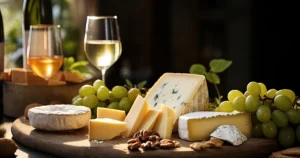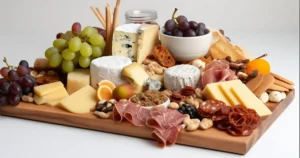Indulge in the final chapter of “Food and Wine Pairings: Charcuterie Boards & the Art of Meat, Cheese, and Wine.” How to serve fortified wines.
In this last installment, we venture into the world of dessert and fortified wines, a realm of sweet complexity and indulgence.
As we delve into Port, Sherry, Madeira, Sauternes, and Ice Wine, we’ll uncover the intricate relationships between meats, cheeses, fruits, nuts, carbohydrates, and olives that enhance these wines’ unique qualities.
Join us in savoring the symphony of flavors that conclude our journey, where every bite and sip blend into a crescendo of culinary delight.
Dessert and Fortified Wines

Port Wine Dessert Pairings
- Cheese: Stilton, Roquefort
- Charcuterie: None (typically enjoyed with sweets)
- Fruit: Dark chocolate, Dried cherries
- Nuts: Walnuts, Hazelnuts
- Carbohydrate: Chocolate-covered strawberries
- Olive: None (typically not paired with olives)
Port’s luscious sweetness finds its match in bold cheeses like Stilton and Roquefort, creating a harmonious contrast that balances the wine’s richness.
As port is often enjoyed with sweets, we can skip the meats and focus on the decadence of dark chocolate and dried cherries that echo the wine’s intensity.
Walnuts and hazelnuts offer a nutty crunch that elevates the experience. Chocolate-covered strawberries provide a luxurious touch, while olives aren’t typically paired with port.
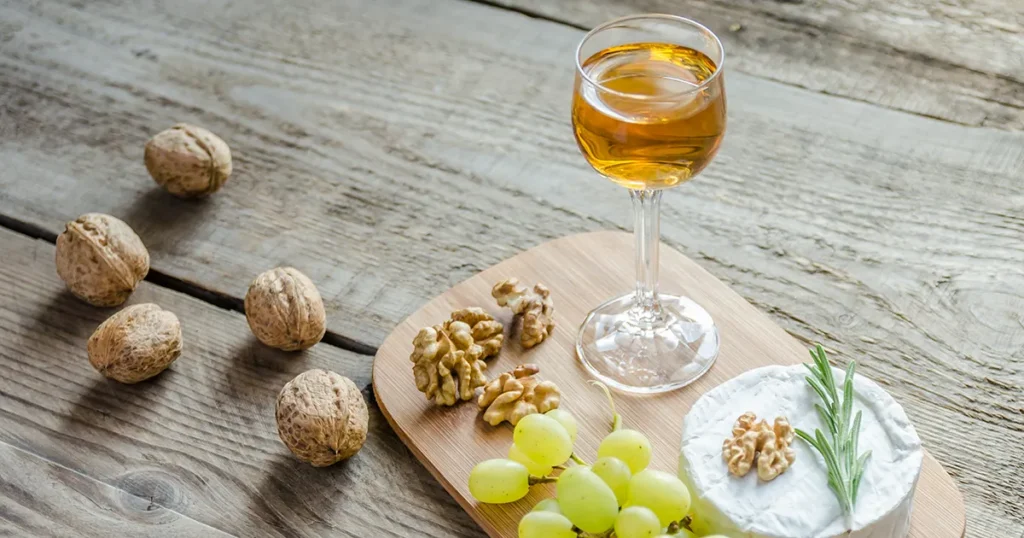
Sherry Pairing
- Cheese: Manchego, Blue cheese
- Charcuterie: Chorizo, Jamón serrano
- Fruit: Almonds, Figs
- Nuts: Marcona almonds, Walnuts
- Carbohydrate: Marinated olives
- Olive: Gordal olives
Sherry’s complexity harmonizes with Manchego and blue cheese, highlighting its depth and character.
Chorizo and Jamón serrano’s robust flavors complement the wine’s intricate notes.
Almonds and figs create a Mediterranean-inspired pairing that resonates with sherry’s origins.
Marcona almonds and walnuts add richness to the ensemble, while marinated olives introduce a tangy and savory element that enhances the wine’s profile.

Madeira Pairing
- Cheese: Brie, Camembert
- Charcuterie: None (often paired with nuts)
- Fruit: Walnuts, Dried apricots
- Nuts: Pecans, Cashews
- Carbohydrate: Fig and almond cake
- Olive: None (typically not paired with olives)
Madeira’s uniqueness is embraced by Brie and Camembert cheeses, echoing the wine’s elegance.
As madeira is often enjoyed with nuts, we’ll focus on walnuts and dried apricots, emphasizing their natural sweetness.
Pecans and cashews offer a variety of textures that enhance the experience.
Fig and almond cake delivers a moist and flavorful carbohydrate that complements the wine. Madeira is not typically paired with olives.
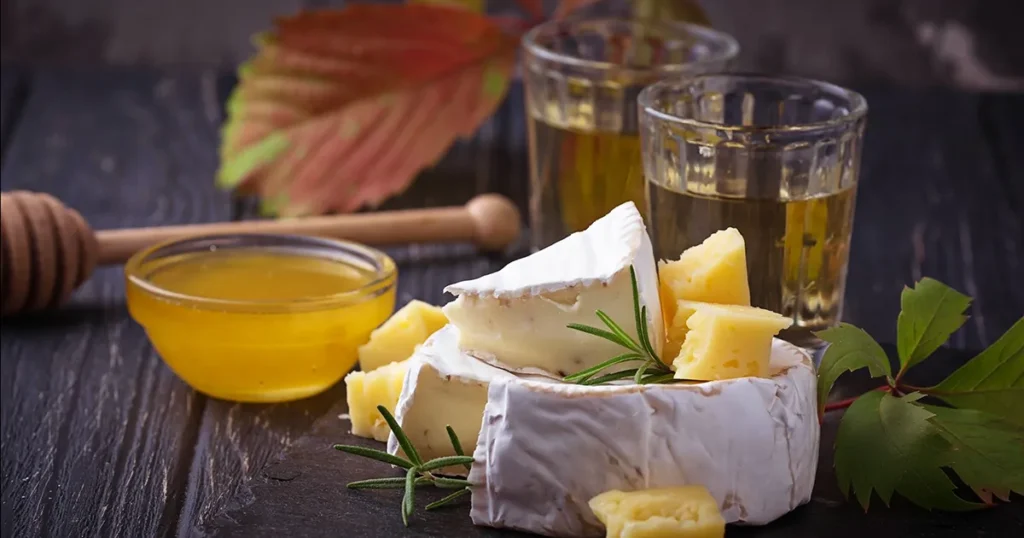
Sauternes Pairing:
- Cheese: Blue cheese, Roquefort
- Charcuterie: None (typically enjoyed with foie gras and desserts)
- Fruit: Honey drizzled over cheese
- Nuts: None (typically not paired with nuts)
- Carbohydrate: Honey-drizzled toast
- Olive: None (typically not paired with olives)
Sauternes’ opulence shines with blue cheese and Roquefort, echoing the wine’s richness and complexity.
Given its association with desserts, we’ll skip the charcuterie. Instead, we’ll focus on drizzling honey over cheese, enhancing the sweet notes of the wine.
French madeleines offer a delicate and cake-like carbohydrate, while olives are not typically paired with Sauternes due to their sweetness.
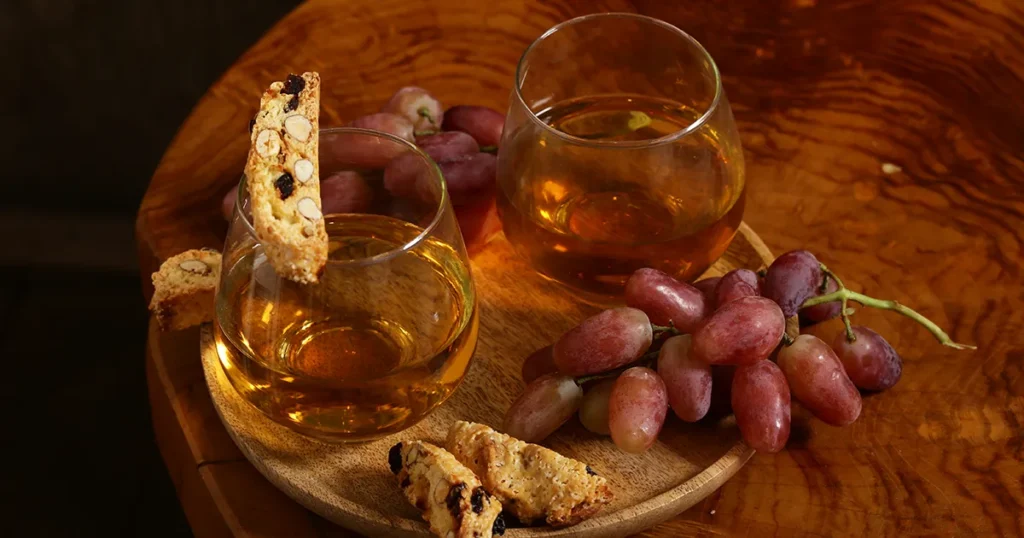
Ice Wine Pairing
- Cheese: Cream cheese, Mascarpone
- Charcuterie: None (usually paired with sweet desserts)
- Fruit: Raspberries, Blueberries
- Nuts: Almonds, Hazelnuts
- Carbohydrate: Shortbread cookies
- Olive: None (typically not paired with olives)
Ice Wine’s sweetness finds a companion in cream cheese and Mascarpone, providing a luxurious backdrop for the wine’s intensity.
As it’s often enjoyed with sweet desserts, we’ll omit the charcuterie.
Raspberries and blueberries mirror the wine’s fruitiness, while almonds and hazelnuts introduce a nutty contrast.
Shortbread cookies offer a buttery and crumbly carbohydrate that pairs well with the wine.
Olives aren’t typically paired with Ice Wine due to their sweetness.
How To Serve Fortified Wine – Final Thoughts
As we bid adieu to our culinary adventure through dessert and fortified wines, we’re reminded of the enchanting experience that charcuterie and wine pairing can offer.
From the luxurious sweetness of Port to the complex elegance of Sherry and the indulgent notes of Madeira, Sauternes, and Ice Wine, each wine has found its perfect ensemble of meats, cheeses, fruits, nuts, carbohydrates, and olives.
The art of pairing goes beyond taste—it’s a symphony that engages the senses, creating a harmonious balance that transforms each bite and sips into a moment of pure indulgence.
So, as you savor these delectable pairings, may you relish every sensation and toast to the artful union of food and wine.
Having delved into the potential of dessert and fortified wines, we encourage you to start your own culinary journey.
Designing a charcuterie board that resonates with the sweet and complex notes of these wines requires expertise and a flair for pairing.
If you’re planning an event where the decadent fusion of meats, cheeses, fruits, nuts, carbohydrates, and olives takes center stage, our dedicated booking team is here to assist you.
Be it a refined soirée or a celebration of life’s pleasures, let us curate a charcuterie board that harmonizes seamlessly with your chosen dessert and fortified wines.
Connect with us to ensure your event is an exceptional and unforgettable experience for you and your guests.


